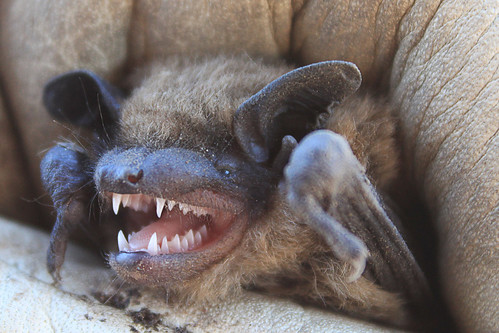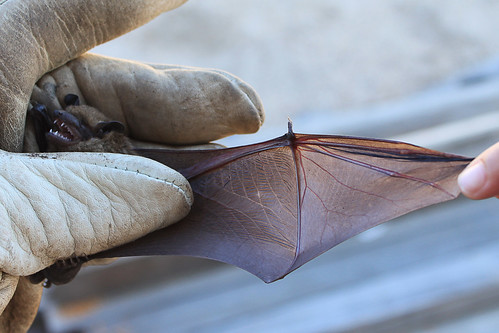
Say hello to my little friend
The old hay barn on the ranch where we live is filled with bats. As a kid, I remember watching them come flying out of that barn around sunset every summer evening. Now our boys enjoy watching the same spectacle. I started thinking about how many bugs they must eat and about how much I hate all those bugs on a warm summer evening. I wanted to find out just how beneficial those little flying mice really are. Here's what I found:
"Bats make good neighbors. As the only major predators of night flying insects, bats play an important role in controlling many insect pests. A single bat can consume as many as 500 insects in just one hour, or nearly 3,000 insects every night. A colony of just 100 little brown bats, the most abundant species in the Northeast, may consume more than a quarter of a million mosquitoes and other small insects each night.
Big brown bats, which live primarily in agricultural areas, feed on June bugs, cucumber beetles, green and brown stinkbugs, and leafhoppers. Research has shown that over the course of a summer, a colony of 150 big brown bats can eat 38,000 cucumber beetles, 16,000 June bugs, 19,000 stinkbugs, and 50,000 leafhoppers and can prevent the hatching of 18 million corn rootworms by devouring the adult beetles."
I decided that making a bat house would be a great way to increase our bat numbers and teach the boys something in the process. I realized that all the materials I needed were just lying around waiting to be used, so I went to work.
Inside the bat box
I settled on a "rocket bat box" design and went to work modifying the design to fit my needs. It turned out to be a full day project and then some.
12 foot 4'' x 6'' redwood post
Complete with three covered plexiglass viewing ports for Joshua
Today I went into the barn and gathered up a few bats that couldn't squeeze into any of the already overcrowded crevices. These became my first tenants. We'll see if they decided to return.
The first occupant
Some more bat facts:
"Although some mammals are able to glide, bats are the only mammals that truly fly. That is, they actually flap their wings to propel them in flight. They belong to their own unique order of mammals, called Chiroptera, meaning “hand wing,” which refers to how the finger bones of a bat support its wings. The wings of a bat are actually thin membranes of skin that stretch between the fingers of the front leg and extend to the hind legs and tail. The bat’s finger bones are greatly elongated and serve a purpose similar to struts on an airplane wing, providing support and maneuverability during flight. When at rest, a bat folds its wings alongside its body to protect the delicate finger bones and wing membranes.
Bats live in a variety of habitats, including wetlands, fields, forests, cities, suburbs, and agricultural areas. They usually feed in areas where insects swarm, such as over water and agricultural fields, in forest clearings and along forest edges, and around street lights.
All northeastern bats eat insects and take their prey on the wing. Bats use their mouths to scoop small insects out of the air. Larger insects are often disabled with a quick bite and then carried to the ground or to a perch for eating. If an insect takes last-second evasive action, a bat can flick out a wing to nab the insect and draw it into its mouth. This maneuverability makes bats very efficient insect predators: A bat may consume nearly 50 percent of its body weight in insects in a single night!
Although bats can see quite well, they rely on their hearing for night flying. A highly sophisticated adaptation, called echolocation, enables bats to use their large and well developed ears to navigate and catch prey in total darkness. A bat’s echolocation system makes use of ultrasonic sound pulses and echoes to locate objects. Bats open their mouths in flight and emit a series of ultrasonic sound pulses. These pulses bounce off nearby objects—such as bushes, fences, branches, and insects—then return as echoes to the bat’s ears. Using the information gathered from these echoes, a bat can maneuver to capture an insect or avoid flying into an object.
Bats have one of the lowest reproductive rates for animals their size. Most northeastern bats have just one or two pups per year, and many females do not breed until their second year. This low reproductive rate is partially offset by their long life span. On average, bats live approximately four to six years, and there are some incredible records of bats living twenty to thirty years in the wild.
Because few flying insects are active during the winter months, bats that remain in the Northeast year-round gather in caves and abandoned mines to hibernate. Hibernation is a state of prolonged torpor during which bats greatly reduce their normal metabolic activities. Body temperature in hibernating bats falls from a normal level of more than 100o F to that of the surrounding cave temperature, usually 40–50o F. The heart rate slows to only about twenty beats per minute, as compared to 1,000 beats per minute during flight. By allowing their bodily processes to slow this way, hibernating bats can survive on a very small amount of stored fat during the five- to six-month hibernation period, losing from one-fourth to one-half of their prehibernation weight."





3 comments:
pretty cool!
we've been talking about making a bat house for a while now, but just haven't gotten around to it. I think we'll try to make one that goes in a tree though as I don't really want a large pole sticking up in our yard.
There are lots of different designs to fit your needs at this link. http://free.woodworking-plans.org/bat-house-plans.html
-Greg
This is probably the best article I've found on bats yet! I was a little worried about setting up a bat house. But after his article the only problem I have is bat house placement. Thanks again for such an awesome article!
Post a Comment